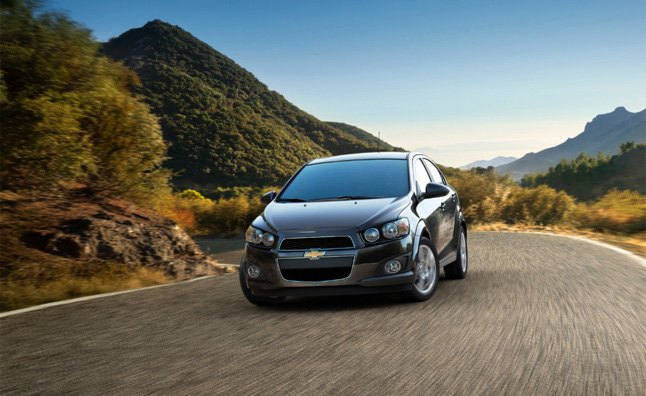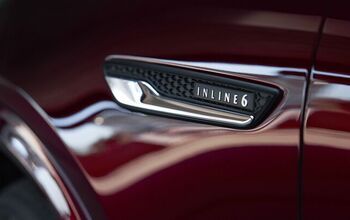Five-Point Inspection: 2012 Chevy Sonic Hatchback 2LT

In case your missed the first installment of AutoGuide’s Five-Point Inspection, this week we’re back to deliver a new car review written in jot note form.
As the name suggests, we forgo some of the niceties to get straight to the facts (and the opinions), breaking down five noteworthy features to help make your new car buying decision easier.
Today, we have the 2012 Chevrolet Sonic, a competitor in the sub-compact car market. Here’s our Five-Point Inspection:
The Sonic offers tons of convenient places to store your cargo, all within arm’s reach. While the small size of car classifies it as a sub-compact, the amount of places to stash your spare change, phone and drinks are abundant.
While most of the storage spaces are small, they are also all separate, which is a nice departure from the, ‘one big storage spot for everything’ philosophy found in many center consoles. Having driven the car on a long road trip to New York City, it was nice to have individual places for papers and drinks that were far away from the change for toll roads.
In addition to the pair of small cubbies on either side of the radio, there is another storage recess in the lower center console, while each door has a storage pocket and there are two (yes two), glove boxes.
In the sub-compact segment, the handling of a car usually gets overridden by other features that automakers think are more suited to the demographic, and therefore more worthy of R&D dollars, but not in the Sonic. It returns a great deal of feedback to the driver when pushing it into corners, body roll is quite minimal (especially for a machine that looks quite tall and narrow) and it bites excellently on turn in; a surprising attribute such an affordable car.
Surprisingly then, at highway speeds the steering is quite light, and doesn’t feel to jittery or jumpy, which can be the case with many other small cars. An affordable car that is actually rewarding to drive is generally hard to come by, but the Sonic’s steering and suspension provides plenty of fun for the enthusiast while still retaining a livable drive quality.
Inexpensive does not have to mean boring, and the information cluster and center console in the car prove exactly that. The motorcycle-inspired information cluster is lifted from the typical dashboard integration, and protrudes as its own unit, sitting on top of the dash rather than being recessed into it. Not only does it give the dash some unique style, the layout of info is exceedingly simple, and can all be digested at a quick glance.
The center console is laid out ergonomically, with a slight recess separating stereo controls from climate controls, making it easy to distinguish one from the other. While the exterior of the car has some sporty lines, the interior is really the big story here, showing off that interesting design ideas don’t always have to come at a premium price.
Equipped with the 1.8-liter engine and six-speed automatic transmission our test car had perhaps the least-desirable drivetrain setup. The automatic transmission is a little confused on the car, and it hunts for gears quite a bit. In fact, six gears might be one too many here.
With 138 hp and and 125 lb-ft of torque at 3800 rpm the car doesn’t feel like it has much until about third gear and then it tappers off quickly. Designed to deliver better fuel economy, the six-speed auto is also reluctant to gear down.
The six-speed manual would help solve many of these problems, though the lack of torque would still be an issue. The real gem is the available 1.4-liter turbo that makes the same horsepower, but boosts the torque rating significantly to 148 lb-ft.
The biggest disappointment, however, was the 27 mpg that we averaged. That’s not far off the car’s 25 mpg city and 35 mpg highway rating, though as a road trip most of our miles were cruising at highway speeds. If anything this is a warning to ignore the advertised 40 mpg claims unless that’s the exact car model you’re buying. Added miles per gallon is fair trade off for lackluster acceleration and an odd transmission, but in this case it’s just not worth it.
While getting best-in-class torque, the price tag on the Sonic sits above almost all of its main competitors, many of which have of the same amenities at a lower price. The Hyundai Accent costs slightly less at $14,545 and gets 40 mpg on all models while the Yaris is priced at $14,115 and the Kia Rio comes in at just $13,600. Getting into a base Chevy Sonic will cost you $14,495.
The largest problem with this base price is that for about $2,000 extra you can get a base Cruze. What’s more, a dressed up Sonic can cost as much as a Cruze, giving you good reason to chose something other than a Sonic, even within the Chevy lineup.

Stephen covers all of the day-to-day events of the industry as the News Editor at AutoGuide, along with being the AG truck expert. His truck knowledge comes from working long days on the woodlot with pickups and driving straight trucks professionally. When not at his desk, Steve can be found playing his bass or riding his snowmobile or Sea-Doo. Find Stephen on <A title="@Selmer07 on Twitter" href="http://www.twitter.com/selmer07">Twitter</A> and <A title="Stephen on Google+" href="http://plus.google.com/117833131531784822251?rel=author">Google+</A>
More by Stephen Elmer





































Comments
Join the conversation
I can't believe GM still offers that 1.8L engine. It totally blows.